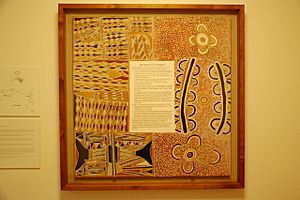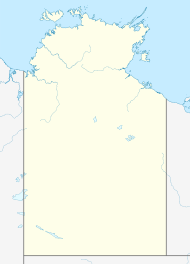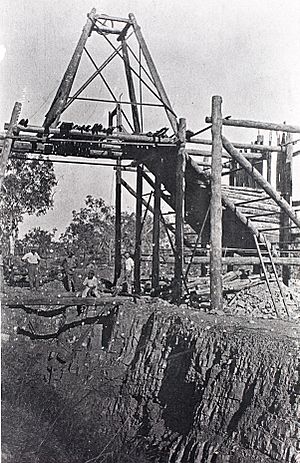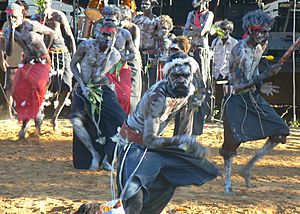Barunga, Northern Territory facts for kids
Quick facts for kids BarungaNorthern Territory |
|
|---|---|
| Postcode(s) | 0852 |
| LGA(s) | Roper Gulf Region |
| Territory electorate(s) | Arnhem |
| Federal Division(s) | Lingiari |
Barunga is a small Aboriginal community in Australia's Northern Territory. It's about 80 kilometers (50 miles) southeast of Katherine. This community is part of the Roper Gulf Region. In 2011, Barunga had a population of 313 people.
Barunga was once known as Beswick Creek. Later, it was called Bamyili before becoming Barunga.
Each year in mid-June, Barunga hosts the Barunga Festival. This three-day event celebrates Australian Aboriginal culture. In 1988, a special document called the Barunga Statement was presented here. It asked for a treaty between the Australian government and Indigenous Australians. Just before the 2018 festival, the Barunga agreement was signed. This agreement was between the Northern Territory Government and four land councils.
Contents
Barunga's Past: A Look Back
Aboriginal people have lived in the Barunga area for thousands of years. Their history is very long and important.
Maranboy Tin Mine Story
In 1913, a goldfield called Maranboy was created. Maranboy was only 8 kilometers (5 miles) from where Barunga is today.
Tin was found there in 1913 by two explorers, Scharber and Richardson. Tin mines and a processing plant started working that same year. People from Europe, China, and Aboriginal communities worked at Maranboy. The mine closed in 1949 for repairs but never opened again. Many Aboriginal people who worked at the mine moved back to Beswick Creek.
Nearby Plane Crash
In 1947, a Douglas DC-3 plane from the Dutch Air Force crash-landed. It happened near Beswick Creek or Beswick (now Wugularr). Everyone on the plane survived. Four crew members walked about 100 miles (160 km) down the Katherine River to get help. They ran out of food and had to kill one of their dogs. Later, the plane's wings were removed. The rest of the plane was towed to Katherine.
Tandangal Settlement
The Tandangal Native Settlement was set up in 1947. It was also known as the Eight Mile Settlement. The name Tandangal comes from the Jawoyn language. This settlement was about 13 kilometers (8 miles) from Beswick Station. Local Aboriginal people were not asked about the location. They were also not asked about how they were moved there.
In 1948, the Beswick community moved to Tandangal. This was because of flood risks from heavy rains. An influenza sickness spread through the community in May 1951.
In June 1951, people moved again to a new site. This new place was first called Beswick Creek Native Settlement. Tandangal was then closed down.
Returning to Beswick Creek
By November 1951, the flu had sadly caused seven deaths.
In early 1951, the Northern Territory Government began to develop the Beswick Creek community. They built basic homes and created some small jobs. Local farmers also hired Aboriginal people. They even had a peanut farm at Beswick Creek for a few years. As Beswick grew, new groups formed a camp across the river. This camp was known as "The Compound." People there built traditional shelters called humpies.
From the 1950s to Today
The Barunga school first opened in 1954. It had 42 children enrolled.
In 1965, the elders changed the name of "The Compound" to Bamyili. Then, in 1984, its name changed again to Barunga.
The first Barunga Festival was held in 1985. In 1988, the Barunga Statement was given to the prime minister at the festival.
Community Facilities
Barunga School teaches students from preschool up to middle years. Students up to Year 12 can get support from the NT Open Education Centre. As of 2020, the school is working with Wugularr and Bulman schools. They are doing this through a program called Vocational Education and Training (VET).
The Bagala Community Store opened in September 2017. Local women saw a need for good, affordable food. This store is special because it is the only one in the Northern Territory fully owned and run by Indigenous people. It sells fresh food, other groceries, hardware, and appliances.
The community also has a health clinic, camping grounds, and a sports oval. There are basketball courts, a softball pitch, and a council office.
The Barunga Festival
Bangardi Robert Lee (1952–2005) started the Barunga Sport and Cultural Festival in 1985. He was a leader of the Bagala clan of the Jawoyn people. The festival became an important place to share ideas. It also showcases Aboriginal Australian and Torres Strait Islander cultures and talents. People also discuss social and political issues there.
It is now an annual music and cultural celebration. It happens on the Queen's Birthday long weekend in June. Over 4,000 people attend. The festival includes workshops, traditional dancing ceremonies, and bush tucker-gathering. You can also see didgeridoo-making, basket weaving, music, and sports.
In 2018, the popular Tiwi band B2M played at the festival.
The 2020 festival was moved from June to September. Then it was cancelled because of the COVID-19 pandemic. The 2021 event happened as planned from June 11–13.
The Barunga Statement (1988)

In 1988, Australia was celebrating its Bicentennial. The prime minister, Bob Hawke, visited the Barunga Festival. There, he received a special document. It was a statement of Aboriginal political goals. Galarrwuy Yunupingu and Wenten Rubuntja presented it to him. This document was painted on a large piece of wood, 1.2 meters (about 4 feet) square. It became known as the "Barunga Statement."
The statement said:
- "We, the Indigenous owners and occupiers of Australia, call on the Australian Government and people to recognise our rights:"
- To make our own decisions and manage ourselves. This includes being free to develop our economy, society, religion, and culture.
- To always control and enjoy our traditional lands.
- To be paid for losing the use of our lands. Our original ownership was never ended.
- To protect our sacred sites, objects, artworks, and knowledge. Also, to control who can access them.
- To have the remains of our ancestors returned for burial. This is so we can follow our traditions.
- To respect and promote our Aboriginal identity. This includes our culture, languages, religion, and history. It also includes the right to learn in our own languages and about our own culture and history.
- To have rights like life, freedom, safety, food, housing, healthcare, education, and jobs. These are basic human rights.
The statement also asked the government to pass laws for:
- A national elected Aboriginal and Islander group to manage Aboriginal and Islander matters.
- A national system for land rights.
- A police and justice system that respects our traditional laws. It should also free us from unfair treatment.
Finally, the statement asked the Australian Government to support Aboriginal people. This support would help create an international declaration of principles for Indigenous rights. It also asked for a Treaty to be negotiated. This treaty would recognize their past ownership, continued presence, and human rights.
Prime Minister Hawke said he wanted to create a treaty by 1990. However, this wish was not fulfilled. There was some discussion about sacred material shown in the bark painting. This led some Indigenous leaders to ask for its return.
In 1991, Bob Hawke's last act as prime minister was to hang the Barunga Statement. He placed it in Parliament House, Canberra. He did this just before Paul Keating became the new prime minister. Hawke said its presence there would remind future leaders to keep working on issues facing Aboriginal people.
Yothu Yindi's Song "Treaty"
In June 1991, the Australian Aboriginal band Yothu Yindi released their hit song "Treaty". They wrote it to remember the Barunga Statement. The lead singer, Mandawuy Yunupingu, and his older brother Galarrwuy wanted to show that little progress had been made on the treaty.
Mandawuy explained how the song started:
Bob Hawke visited the Territory. He went to this gathering in Barunga. And this is where he made a statement that there shall be a treaty between black and white Australia. Sitting around the camp fire, trying to work out a chord to the guitar, and around that camp fire, I said, "Well, I heard it on the radio. And I saw it on the television." That should be a catchphrase. And that's where 'Treaty' was born.
The Barunga Agreement (2018)
On June 8, 2018, a new agreement was signed. This happened just before the Barunga Festival opened. The Northern Territory Government signed a Memorandum of Understanding (MoU). This agreement is now known as the Barunga agreement. It started talks about a treaty with all four of the Territory's Aboriginal land councils.
The agreement was written after a week of talks. About 200 elected members from the land councils were involved. It included some guiding ideas. One key idea was that "Aboriginal people were the prior owners and occupiers of the land, seas and waters that are now called the NT of Australia." The land councils involved were the Northern, Central, Anindilyakwa, and Tiwi Land Councils.
An important part of the agreement was truth telling. One leader said, "Truth telling is critical. Unless we understand each other, and understand how we've been impacted even by the best intentions of the other side, it's pretty hard to construct a new relationship."
Only two of the nine senior men who painted the Barunga Statement in 1988 were still alive. They were Rirratjingu clan leader Galarrwuy Yunupingu and fellow Yolngu leader Djambawa Marawili. Both were present when the 2018 treaty agreement was signed.





